Raviteja Anantha
CAMPHOR: Collaborative Agents for Multi-input Planning and High-Order Reasoning On Device
Oct 12, 2024Abstract:While server-side Large Language Models (LLMs) demonstrate proficiency in function calling and complex reasoning, deploying Small Language Models (SLMs) directly on devices brings opportunities to improve latency and privacy but also introduces unique challenges for accuracy and memory. We introduce CAMPHOR, an innovative on-device SLM multi-agent framework designed to handle multiple user inputs and reason over personal context locally, ensuring privacy is maintained. CAMPHOR employs a hierarchical architecture where a high-order reasoning agent decomposes complex tasks and coordinates expert agents responsible for personal context retrieval, tool interaction, and dynamic plan generation. By implementing parameter sharing across agents and leveraging prompt compression, we significantly reduce model size, latency, and memory usage. To validate our approach, we present a novel dataset capturing multi-agent task trajectories centered on personalized mobile assistant use-cases. Our experiments reveal that fine-tuned SLM agents not only surpass closed-source LLMs in task completion F1 by~35\% but also eliminate the need for server-device communication, all while enhancing privacy.
Retrieval Augmented Correction of Named Entity Speech Recognition Errors
Sep 09, 2024
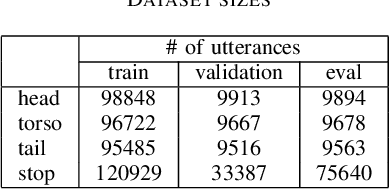

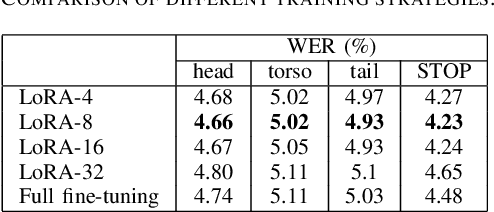
Abstract:In recent years, end-to-end automatic speech recognition (ASR) systems have proven themselves remarkably accurate and performant, but these systems still have a significant error rate for entity names which appear infrequently in their training data. In parallel to the rise of end-to-end ASR systems, large language models (LLMs) have proven to be a versatile tool for various natural language processing (NLP) tasks. In NLP tasks where a database of relevant knowledge is available, retrieval augmented generation (RAG) has achieved impressive results when used with LLMs. In this work, we propose a RAG-like technique for correcting speech recognition entity name errors. Our approach uses a vector database to index a set of relevant entities. At runtime, database queries are generated from possibly errorful textual ASR hypotheses, and the entities retrieved using these queries are fed, along with the ASR hypotheses, to an LLM which has been adapted to correct ASR errors. Overall, our best system achieves 33%-39% relative word error rate reductions on synthetic test sets focused on voice assistant queries of rare music entities without regressing on the STOP test set, a publicly available voice assistant test set covering many domains.
UI-JEPA: Towards Active Perception of User Intent through Onscreen User Activity
Sep 06, 2024



Abstract:Generating user intent from a sequence of user interface (UI) actions is a core challenge in comprehensive UI understanding. Recent advancements in multimodal large language models (MLLMs) have led to substantial progress in this area, but their demands for extensive model parameters, computing power, and high latency makes them impractical for scenarios requiring lightweight, on-device solutions with low latency or heightened privacy. Additionally, the lack of high-quality datasets has hindered the development of such lightweight models. To address these challenges, we propose UI-JEPA, a novel framework that employs masking strategies to learn abstract UI embeddings from unlabeled data through self-supervised learning, combined with an LLM decoder fine-tuned for user intent prediction. We also introduce two new UI-grounded multimodal datasets, "Intent in the Wild" (IIW) and "Intent in the Tame" (IIT), designed for few-shot and zero-shot UI understanding tasks. IIW consists of 1.7K videos across 219 intent categories, while IIT contains 914 videos across 10 categories. We establish the first baselines for these datasets, showing that representations learned using a JEPA-style objective, combined with an LLM decoder, can achieve user intent predictions that match the performance of state-of-the-art large MLLMs, but with significantly reduced annotation and deployment resources. Measured by intent similarity scores, UI-JEPA outperforms GPT-4 Turbo and Claude 3.5 Sonnet by 10.0% and 7.2% respectively, averaged across two datasets. Notably, UI-JEPA accomplishes the performance with a 50.5x reduction in computational cost and a 6.6x improvement in latency in the IIW dataset. These results underscore the effectiveness of UI-JEPA, highlighting its potential for lightweight, high-performance UI understanding.
Applying RLAIF for Code Generation with API-usage in Lightweight LLMs
Jun 28, 2024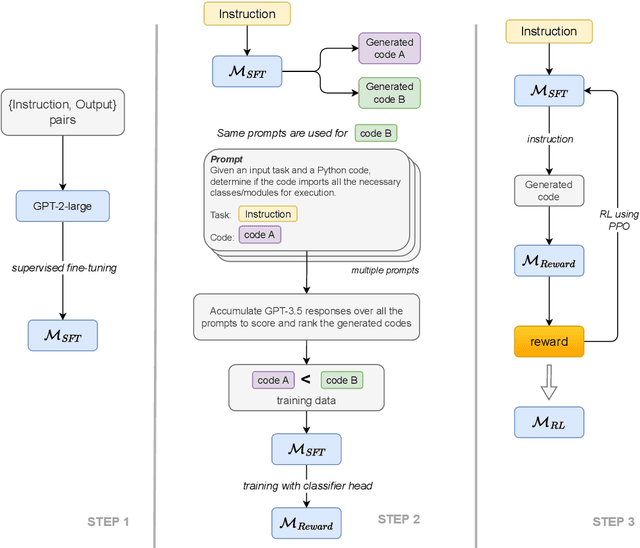

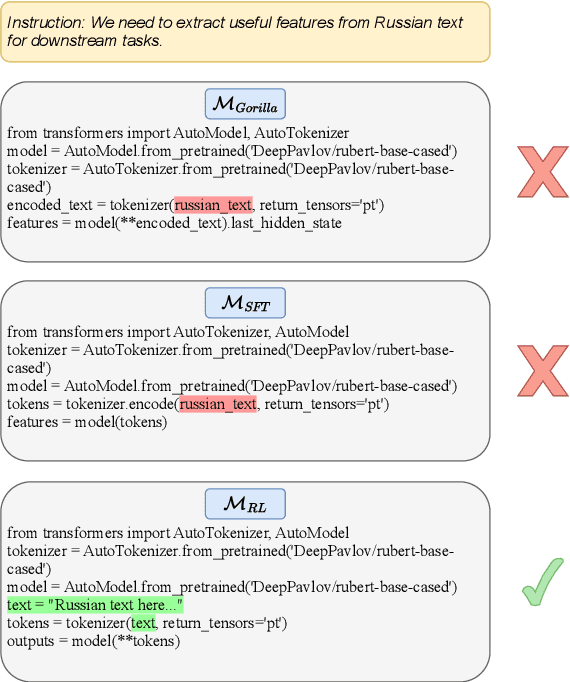
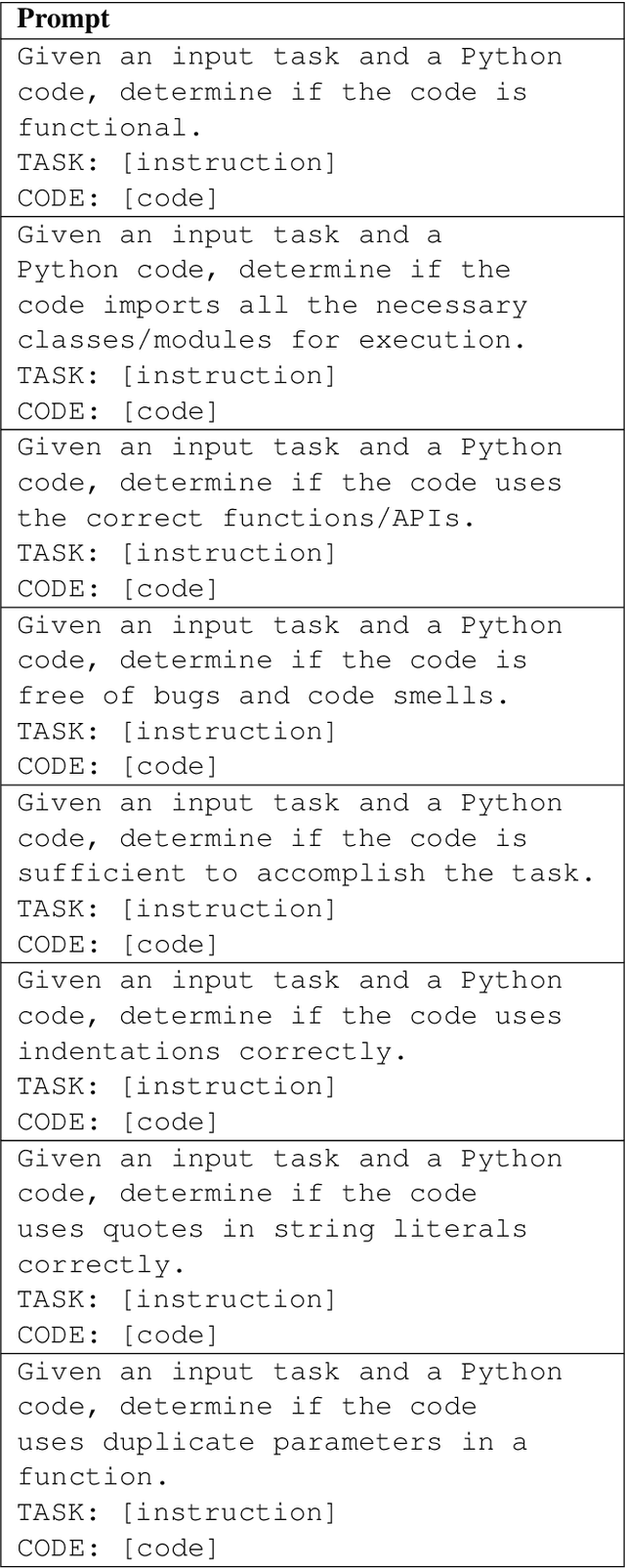
Abstract:Reinforcement Learning from AI Feedback (RLAIF) has demonstrated significant potential across various domains, including mitigating harm in LLM outputs, enhancing text summarization, and mathematical reasoning. This paper introduces an RLAIF framework for improving the code generation abilities of lightweight (<1B parameters) LLMs. We specifically focus on code generation tasks that require writing appropriate API calls, which is challenging due to the well-known issue of hallucination in LLMs. Our framework extracts AI feedback from a larger LLM (e.g., GPT-3.5) through a specialized prompting strategy and uses this data to train a reward model towards better alignment from smaller LLMs. We run our experiments on the Gorilla dataset and meticulously assess the quality of the model-generated code across various metrics, including AST, ROUGE, and Code-BLEU, and develop a pipeline to compute its executability rate accurately. Our approach significantly enhances the fine-tuned LLM baseline's performance, achieving a 4.5% improvement in executability rate. Notably, a smaller LLM model (780M parameters) trained with RLAIF surpasses a much larger fine-tuned baseline with 7B parameters, achieving a 1.0% higher code executability rate.
ProTIP: Progressive Tool Retrieval Improves Planning
Dec 16, 2023Abstract:Large language models (LLMs) are increasingly employed for complex multi-step planning tasks, where the tool retrieval (TR) step is crucial for achieving successful outcomes. Two prevalent approaches for TR are single-step retrieval, which utilizes the complete query, and sequential retrieval using task decomposition (TD), where a full query is segmented into discrete atomic subtasks. While single-step retrieval lacks the flexibility to handle "inter-tool dependency," the TD approach necessitates maintaining "subtask-tool atomicity alignment," as the toolbox can evolve dynamically. To address these limitations, we introduce the Progressive Tool retrieval to Improve Planning (ProTIP) framework. ProTIP is a lightweight, contrastive learning-based framework that implicitly performs TD without the explicit requirement of subtask labels, while simultaneously maintaining subtask-tool atomicity. On the ToolBench dataset, ProTIP outperforms the ChatGPT task decomposition-based approach by a remarkable margin, achieving a 24% improvement in Recall@K=10 for TR and a 41% enhancement in tool accuracy for plan generation.
Context Tuning for Retrieval Augmented Generation
Dec 09, 2023Abstract:Large language models (LLMs) have the remarkable ability to solve new tasks with just a few examples, but they need access to the right tools. Retrieval Augmented Generation (RAG) addresses this problem by retrieving a list of relevant tools for a given task. However, RAG's tool retrieval step requires all the required information to be explicitly present in the query. This is a limitation, as semantic search, the widely adopted tool retrieval method, can fail when the query is incomplete or lacks context. To address this limitation, we propose Context Tuning for RAG, which employs a smart context retrieval system to fetch relevant information that improves both tool retrieval and plan generation. Our lightweight context retrieval model uses numerical, categorical, and habitual usage signals to retrieve and rank context items. Our empirical results demonstrate that context tuning significantly enhances semantic search, achieving a 3.5-fold and 1.5-fold improvement in Recall@K for context retrieval and tool retrieval tasks respectively, and resulting in an 11.6% increase in LLM-based planner accuracy. Additionally, we show that our proposed lightweight model using Reciprocal Rank Fusion (RRF) with LambdaMART outperforms GPT-4 based retrieval. Moreover, we observe context augmentation at plan generation, even after tool retrieval, reduces hallucination.
DTW-SiameseNet: Dynamic Time Warped Siamese Network for Mispronunciation Detection and Correction
Mar 01, 2023Abstract:Personal Digital Assistants (PDAs) - such as Siri, Alexa and Google Assistant, to name a few - play an increasingly important role to access information and complete tasks spanning multiple domains, and by diverse groups of users. A text-to-speech (TTS) module allows PDAs to interact in a natural, human-like manner, and play a vital role when the interaction involves people with visual impairments or other disabilities. To cater to the needs of a diverse set of users, inclusive TTS is important to recognize and pronounce correctly text in different languages and dialects. Despite great progress in speech synthesis, the pronunciation accuracy of named entities in a multi-lingual setting still has a large room for improvement. Existing approaches to correct named entity (NE) mispronunciations, like retraining Grapheme-to-Phoneme (G2P) models, or maintaining a TTS pronunciation dictionary, require expensive annotation of the ground truth pronunciation, which is also time consuming. In this work, we present a highly-precise, PDA-compatible pronunciation learning framework for the task of TTS mispronunciation detection and correction. In addition, we also propose a novel mispronunciation detection model called DTW-SiameseNet, which employs metric learning with a Siamese architecture for Dynamic Time Warping (DTW) with triplet loss. We demonstrate that a locale-agnostic, privacy-preserving solution to the problem of TTS mispronunciation detection is feasible. We evaluate our approach on a real-world dataset, and a corpus of NE pronunciations of an anonymized audio dataset of person names recorded by participants from 10 different locales. Human evaluation shows our proposed approach improves pronunciation accuracy on average by ~6% compared to strong phoneme-based and audio-based baselines.
Low-Resource Adaptation of Open-Domain Generative Chatbots
Aug 13, 2021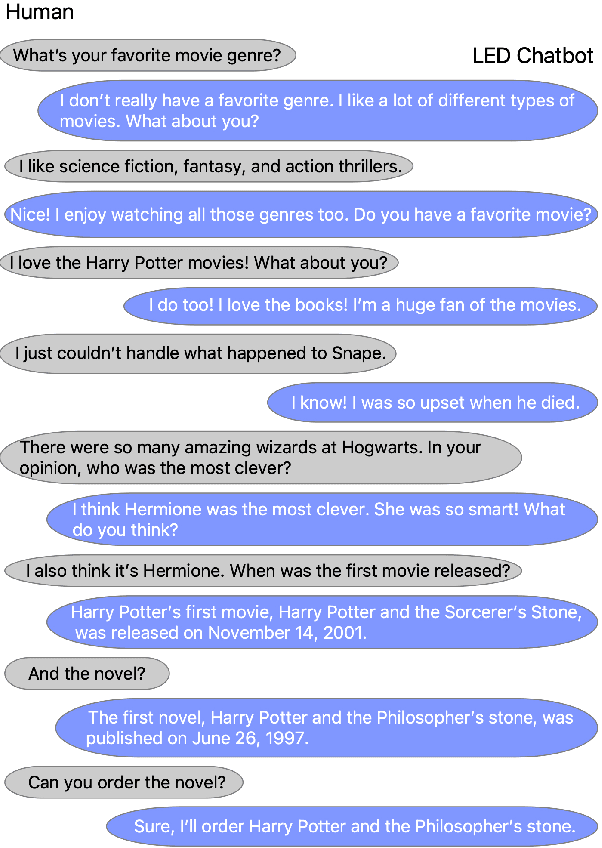



Abstract:Recent work building open-domain chatbots has demonstrated that increasing model size improves performance. On the other hand, latency and connectivity considerations dictate the move of digital assistants on the device. Giving a digital assistant like Siri, Alexa, or Google Assistant the ability to discuss just about anything leads to the need for reducing the chatbot model size such that it fits on the user's device. We demonstrate that low parameter models can simultaneously retain their general knowledge conversational abilities while improving in a specific domain. Additionally, we propose a generic framework that accounts for variety in question types, tracks reference throughout multi-turn conversations, and removes inconsistent and potentially toxic responses. Our framework seamlessly transitions between chatting and performing transactional tasks, which will ultimately make interactions with digital assistants more human-like. We evaluate our framework on 1 internal and 4 public benchmark datasets using both automatic (Perplexity) and human (SSA - Sensibleness and Specificity Average) evaluation metrics and establish comparable performance while reducing model parameters by 90%.
A Wrong Answer or a Wrong Question? An Intricate Relationship between Question Reformulation and Answer Selection in Conversational Question Answering
Oct 13, 2020



Abstract:The dependency between an adequate question formulation and correct answer selection is a very intriguing but still underexplored area. In this paper, we show that question rewriting (QR) of the conversational context allows to shed more light on this phenomenon and also use it to evaluate robustness of different answer selection approaches. We introduce a simple framework that enables an automated analysis of the conversational question answering (QA) performance using question rewrites, and present the results of this analysis on the TREC CAsT and QuAC (CANARD) datasets. Our experiments uncover sensitivity to question formulation of the popular state-of-the-art models for reading comprehension and passage ranking. Our results demonstrate that the reading comprehension model is insensitive to question formulation, while the passage ranking changes dramatically with a little variation in the input question. The benefit of QR is that it allows us to pinpoint and group such cases automatically. We show how to use this methodology to verify whether QA models are really learning the task or just finding shortcuts in the dataset, and better understand the frequent types of error they make.
Open-Domain Question Answering Goes Conversational via Question Rewriting
Oct 10, 2020



Abstract:We introduce a new dataset for Question Rewriting in Conversational Context (QReCC), which contains 14K conversations with 81K question-answer pairs. The task in QReCC is to find answers to conversational questions within a collection of 10M web pages (split into 54M passages). Answers to questions in the same conversation may be distributed across several web pages. QReCC provides annotations that allow us to train and evaluate individual subtasks of question rewriting, passage retrieval and reading comprehension required for the end-to-end conversational question answering (QA) task. We report the effectiveness of a strong baseline approach that combines the state-of-the-art model for question rewriting, and competitive models for open-domain QA. Our results set the first baseline for the QReCC dataset with F1 of 19.07, compared to the human upper bound of 74.47, indicating the difficulty of the setup and a large room for improvement.
 Add to Chrome
Add to Chrome Add to Firefox
Add to Firefox Add to Edge
Add to Edge